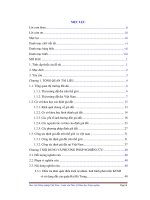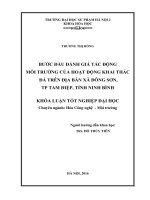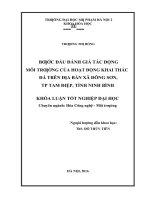Đánh giá thời gian biệt trữ bán thành phẩm
Bạn đang xem bản rút gọn của tài liệu. Xem và tải ngay bản đầy đủ của tài liệu tại đây (97.31 KB, 5 trang )
Available online at www.pelagiaresearchlibrary.com
Pelagia Research Library
Der Pharmacia Sinica, 2012, 3 (2):300-304
ISSN: 0976-8688
CODEN (USA): PSHIBD
Hold time study for pharmaceutical binders, lubricated granules, compressed
tablets, coating suspension and coated tablets during manufacturing process
Deepak. P. Pawar*, Prashant. B. Shamkuwar and Avinash. H. Hosmani
Government College of Pharmacy, Thiba Palace, Ratnagiri
_____________________________________________________________________________________________
ABSTRACT
Although there are no specific regulations of guidance document on bulk product holding times, good
manufacturing practice dictates that holding should be validated to ensure that in process and bulk product can be
held, pending the next processing step, without any adverse effect to the quality of the material. The time period for
which the product is on hold shall be justified with adequate data to demonstrate the product will be stable
throughout the approved shelf life. The time during which the product is stored in the bulk container, prior to
packing into the final immediate container, constitutes part of the approved shelf life, i.e., the date of expiry remains
a function of the date of manufacture, not the date of packing. The conclusions from this article may lead to
guidelines on sampling, storage and holding times for Pharmaceutical Tablet and during manufacturing process.
Most appropriate storage and preservation protocol should be based on the specific study objectives and focus.
Key words: Hold time study; Binders, Lubricated Granules, Tablets and Coated tablets.
_____________________________________________________________________________________________
INTRODUCTION
Many times, in industry the material is kept on maximum allowable hold time which should be established for bulk
and in-process drug products [1]. Although regulatory agencies expect manufacturers to document and address hold
times, they do not describe a process for establishing hold time practice of sampling, storage for pharmaceutical
tablet and injection during manufacturing process. The time period for which the product is on hold shall be justified
with adequate data to demonstrate the product will be stable throughout the approved shelf life [2, 3]. In such case
the manufacturer shall produce sufficient data demonstrating that the product is stable for said period of time before
processing to the next stage and it will meet the acceptance criteria for the finished product as well as stability
specifications. The time during which the product is stored in the bulk container, prior to packing into the final
immediate container, constitutes part of the approved shelf life, i.e., the date of expiry remains a function of the date
of manufacture, not the date of packing [4]. Bulk products, which are stored for a period of time prior to packing
into the final containers for 25% or more of the approved shelf life, should be tested, with stability indicating
methods, prior to packaging [5]. Hold time study establish the time limits of holding the materials at different stages
of production by assuring that the quality of the product does not deteriorate during the hold time. To validate the
holding time of binders, lubricated granules, tablets, coating suspensions and coated tablets under the prevailing
condition, it should be ensured that the result of all process is within the limits of acceptance criteria throughout the
holding time [6].
300
Pelagia Research Library
Deepak. P. Pawar et al
Der Pharmacia Sinica, 2012, 3(2):300-304
______________________________________________________________________________
Figure 1: Hold time study Flow chart in tablet manufacturing process.
Table 1: Sampling points and sampling technique in tablet manufacturing process [7, 8].
Process stage
Binder
Equipment
Steam kettle
Sampling tool
S.S container
Lubrication
Octagonal blender
Sampling thief
Compression
Compression machine
Sampling scoop
Coating Suspension
Coating
Steam kettle
Auto coater
S.S Container
Sampling scoop
Sampling points
Discharge ports of steam kettle [3].
10 points at initial stage from O’blender. 5 kg sample withdraw from top,
middle and bottom in small Intermediate product container (IPC) [7].
Depend upon number station sample withdrawn from left hand side and
right hand side at initial, middle, and end stage of machine run. Mix and
made a composite sample [8].
Discharge ports of steam kettle [3].
Samples are collected from pan at initial, middle, and end portion [3].
Note:
1. On the basis of processing time at each individual stage and subsequent stage we can find the time interval for
numbers of test to be performed.
2. After blending 5kg sample are collected in Intermediate product container (IPC) because in hopper 2 kg granule
are required. For LHS and RHS 4kg sample are required.
301
Pelagia Research Library
Deepak. P. Pawar et al
Der Pharmacia Sinica, 2012, 3(2):300-304
______________________________________________________________________________
Table 2: Stages, test and study time in tablet manufacturing process [4, 6].
Stage
Test to be carried out as per specification
Binder preparation
Microbial counts
Lubricated granule
Compression after 45th day
Compression
Coating suspension
Coated tablets
Study time
Initial, 2hrs, 5hrs, 8hrs. in case of
starch initial, 2hrs, 5hrs.
Description, Assay, loss on drying, water content, particle size distribution,
bulk density, tap density, angle of repose.
Description, hardness, thickness, friability, disintegration, assay,
dissolution or dissolution profile, related substance, uniformity of dosage
units and microbial limits.
Description, hardness, thickness, friability, disintegration, assay,
dissolution or dissolution profile, related substance, uniformity of dosage
units and microbial limits.
Physical appearance, viscosity, sedimentation, pH, microbial counts
Description, hardness, thickness, friability, disintegration, assay,
dissolution or dissolution profile, related substance, uniformity of dosage
units and microbial limits.
Initial, 30th day, 45th day
After lubrication time i.e. 45th day is
over blend is compressed at 45th
day.
Initial, 30th day, 60th day & 90th day
Initial, 12, 24, 36, 48, 60, 72 hours
Initial, 30th day, 60th day & 90th day
Sample quantity required in each stage in tablet manufacturing process:
Table 3: Lubricated Granules
Average weight of standard compressed in gm.
0.160
Sample Quantity required for Hold Study
Test
Sample
quantity in
gm
0
2
3.2
Description
Water content
Assay
Related substance/
1
degradation product
Bioload
5
Lubricated granules compressed at 45th day
Test
Description
Sample quantity
Total Quantity for each test to
be mentioned in Technical
information sheet
0
4
6
Duplicated
0
2
2
For
initial day
For
30th day
For
45th day
12
10
12
NA
10
2
2
2
10
10
Water
content
Assay
Related substance/
degradation product
0
6×2=12
20×2=40
3×2=6
Note: sample quantity should be given in duplicate if 1st sample are fail next should be used.
Dissolution/
dissolution
profiling
6×2=12
Bio-load
16×2=31
Table 4: Compressed tablets
Average weight of standard compressed in gm.
0.350
Sample Quantity required for Hold Study
Test
Sample
quantity in gm
Description
0
Water content
6
Assay
20
Related substance/
3
degradation product
Dissolution/
6
dissolution profiling
Uniformity of dosage units
10
Bioload
14
For physical parameter
Weight variation
10
Thickness variation
10
Friability
21
Disintegration test
6
Total tablets required for hold time study
Duplicated
Total Quantity for each test to be
mentioned in TI sheet
0
2
2
0
12
40
2
6
2
12
2
2
20
29
2
1
2
2
For
initial
day
For
30th
day
For
60th
day
For
90th
day
89
51
51
89
10
NA
NA
10
20
10
42
12
20
10
42
12
20
10
42
12
20
10
42
12
674
302
Pelagia Research Library
Deepak. P. Pawar et al
Der Pharmacia Sinica, 2012, 3(2):300-304
______________________________________________________________________________
Table 5: Coated tablets
Average weight of standard compressed in gm.
0.320
Sample Quantity required for Hold Study
Test
Sample quantity
in gm.
Description
0
Water content
6
Assay
20
Related substance/
3
degradation product
Dissolution/
6
dissolution profiling
Bioload
16
Total tablets required for hold time study
Duplicated
Total Quantity for each test to be
mentioned in TI sheet
0
2
2
0
12
40
2
6
2
12
2
31
For
initial
day
For
30th
day
For
60th
day
For
90th
day
71
53
53
71
31
NA
NA
309
31
Table 6: Binder preparation
Sample Quantity required for Hold Study
Test
Sample quantity in
ml
Duplicated
Total Quantity for each test to be mentioned in TI
sheet
2
200
Bioload
100
Total quantity required for hold time
For
initial
hrs
200
For
2hrs
For
5hrs
For
8hrs
200
200
1200
200
Table 7: Coating suspensions
Test
Sample quantity in ml
Initial hrs
12 hrs
24 hrs
36 hrs
48 hrs
60 hrs
72 hrs
Total
Physical appearance
100×2=200
100×2=200
100×2=200
100×2=200
100×2=200
100×2=200
100×2=200
100×2=200
1400 ml
viscosity
100×2=200
100×2=200
100×2=200
100×2=200
100×2=200
100×2=200
100×2=200
100×2=200
1400 ml
sedimentation
100×2=200
100×2=200
100×2=200
100×2=200
100×2=200
100×2=200
100×2=200
100×2=200
1400 ml
pH
100×2=200
100×2=200
100×2=200
100×2=200
100×2=200
100×2=200
100×2=200
100×2=200
1400 ml
Bioload
100×2=200
100×2=200
100×2=200
100×2=200
100×2=200
100×2=200
100×2=200
100×2=200
1400 ml
Precaution and recommendation [2]:
1. The maximum storage period for each category of material should be established and specified on the basis of a
study by keeping the material in a simulated container used in production.
2. Period of storage material should be as follows.
2.1 Binders:
Binders should be stored at controlled condition for not more than 8 hrs in well closed SS container with status label.
If a binder is made up of starch it should be stored not more than 5 hrs. If storage period exceeds, then retesting
should be performed.
2.2 lubricated granules
Lubricated granules should be stored at controlled condition for not more than 45 days in well closed IPC/SS
container containing double polythene bag with status label. If storage period exceeds, then retesting should be
performed.
2.3 Compressed Tablets:
Compressed tablets should be stored at controlled condition for not more than 90 days in well closed IPC/SS
container containing double polythene bag with status label. If storage period exceeds, then retesting should be
performed
2.4 Coating suspension:
Coating suspension should be stored at controlled condition for not more than 72 hrs in well closed SS container
with status label. If storage period exceeds, then retesting should be performed.
303
Pelagia Research Library
Deepak. P. Pawar et al
Der Pharmacia Sinica, 2012, 3(2):300-304
______________________________________________________________________________
2.5 coated Tablets:
Coated tablets should be stored at controlled condition for not more than 90 days in well closed IPC/SS container
containing double polythene bag with status label. If storage period exceeds, then retesting should be performed.
3. Environmental condition:
For the storage of sample the environmental condition should be same as that of quarantine area /manufacture stage.
CONCLUSION
Present study indicate guidelines on sampling, storage and holding times for Pharmaceutical Binders, Lubricated
Granules, Compressed Tablets, Coating Suspensions and Coated Tablets during manufacturing process. Most
appropriate storage and preservation protocol should be based on the specific study objectives and focus. Statistical
calculations are required to estimate a reliable holding time which is an area of growing concern, with analytical
monitoring studies, appearing more frequently in the literature.
REFERENCES
[1] www.setac New Orleans, 2009.
[2] H Ali, MA Khatri, A Jain, R Modi, A Patel. Drug inventory today, 2011, 3(7), 157-159.
[3] L Lachman. Theory and Practice of Industrial pharmacy (Ed.) Tablet Coating (CBS Publisher and distributers,
New Delhi 2009) 293- 370
[4] QC Bulk Pharmaceuticals Work Group, "PhRMA Guidelines for the Production, Packing, Repacking or Holding
of Drug Substances," Quality Steering Committee, PhRMA Science and Regulatory Section, Part I and Part II,
Pharmaceutical Technology, December 1995 and January 1996.
[5] PMA Committee on Guidelines for Bulk Pharmaceutical Chemicals, PMA Guidelines for the Production,
Packing, Repacking, or Holding of Bulk Pharmaceutical Chemicals, Second Edition, Revised - June 1978.
[6] K Huynh. Hand book of stability testing in pharmaceutical development, 2009
[7] M Hopkins, J Jenkins, M Louge. Advances in Micromechanics of Granular Materials, 1991.
[8] M Tousey. Pharmaceutical Technology. Tableting & Granulation. 2002.
304
Pelagia Research Library









